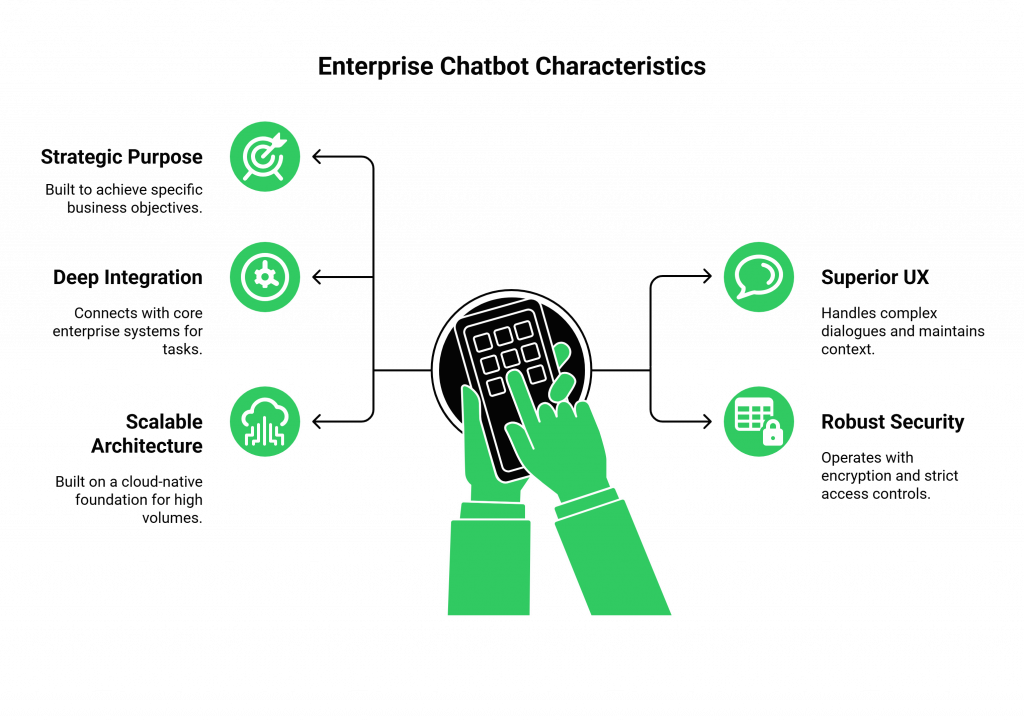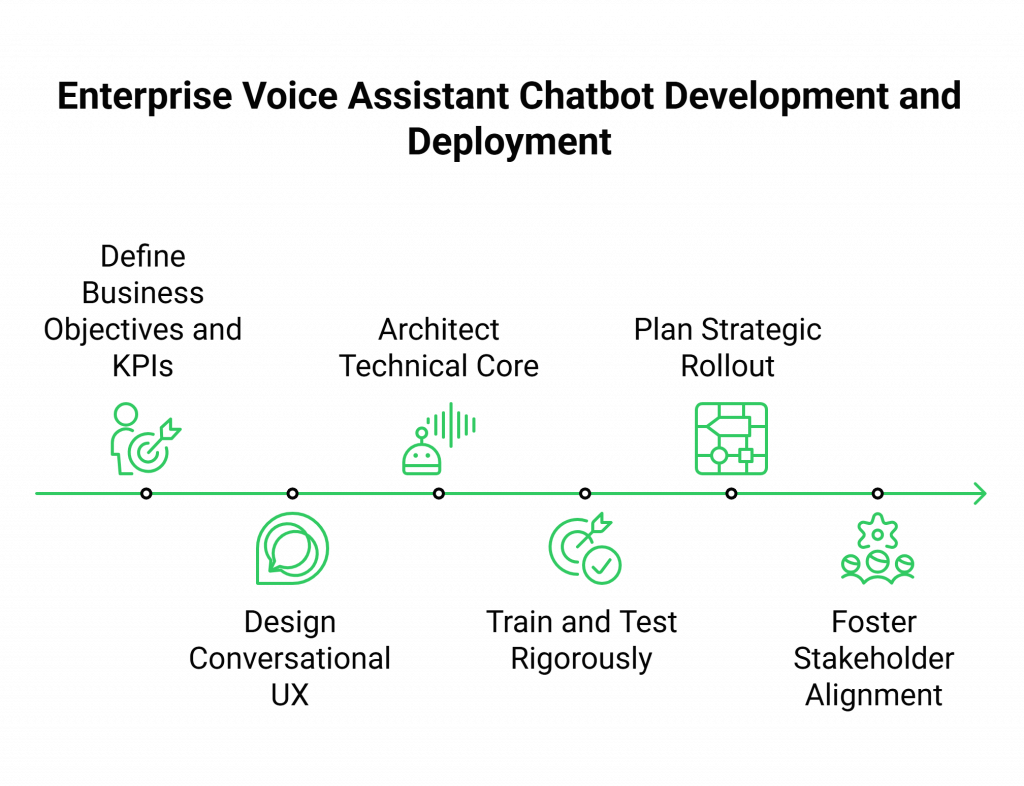The ambition to deploy an enterprise-grade Voice Assistant Chatbot has moved from a strategic advantage to a business imperative. Enterprises today are not just building simple bots; they are architecting sophisticated conversational AI systems designed to automate complex workflows, enhance customer experience, and drive operational efficiency on a global scale. The goal is clear: create an intelligent, secure, and scalable assistant that acts as a true digital extension of the brand.
Table of contents
- What is an Enterprise-Grade Voice Assistant Chatbot?
- The Enterprise Gap: Why Most Voice AI Projects Fail to Scale
- FreJun: The Infrastructure Layer for Your Enterprise AI
- The Two Development Paths: DIY Infrastructure vs. The FreJun Platform
- The Enterprise Blueprint: A 6-Step Guide to Development and Deployment
- Final Thoughts: Focus on Your Intelligence, Not Your Infrastructure
- Frequently Asked Questions (FAQ)
However, a chasm exists between a successful prototype and a resilient, enterprise-ready deployment. Many projects, despite being built on powerful AI engines and sound conversational design, fail to leap. They stall not because the AI is weak, but because the underlying infrastructure is not equipped to handle the rigorous demands of an enterprise environment, particularly the immense complexity of integrating with telephony.
What is an Enterprise-Grade Voice Assistant Chatbot?

An enterprise-grade Voice Assistant Chatbot is a system that goes far beyond basic question-and-answer functionality. It is a deeply integrated, highly secure, and scalable solution defined by several core characteristics:
- Strategic Purpose: It is built to achieve specific, measurable business objectives, such as improving first-contact resolution (FCR) or reducing customer service costs.
- Superior Conversational UX: It handles complex, multi-turn dialogues, maintains context, and allows for natural interruptions and seamless escalation to human agents.
- Deep System Integration: It connects with core enterprise systems like CRMs, ERPs, and knowledge bases to perform transactional tasks and provide personalised, data-driven responses.
- Robust Security and Compliance: It operates with end-to-end encryption, data anonymisation, and strict access controls to meet enterprise and regulatory standards.
- Scalable and Resilient Architecture: It is built on a cloud-native foundation that can handle high volumes of concurrent interactions across multiple regions and channels without failure.
The Enterprise Gap: Why Most Voice AI Projects Fail to Scale
The primary reason voice AI projects fail at the enterprise level is the underestimation of the infrastructure challenge. Teams excel at building the “AI Core”, the conversational brain of the Voice Assistant Chatbot, using platforms like Rasa or Voiceflow and integrating powerful NLP engines. But this is only half the battle.
To deploy this AI Core on the most critical channel for enterprise communication, the telephone, they must also build the “Voice Infrastructure.” This is a completely different and far more complex undertaking. It involves solving a host of non-trivial engineering problems:
- Telephony Integration: Managing complex SIP (Session Initiation Protocol) trunks and carrier relationships to connect to the Public Switched Telephone Network (PSTN).
- Real-Time Media Servers: Building and maintaining a global network of specialized servers to handle raw audio streams from thousands of concurrent calls.
- High Availability and Geo-Redundancy: Engineering a system with automatic failover and disaster recovery to guarantee 99.99%+ uptime, a standard enterprise requirement.
- Enterprise-Grade Security: Securing the entire voice data pipeline, from the handset to the application, to comply with regulations like GDPR and protect against threats.
This is the enterprise gap. Teams of AI and conversation design experts are forced to become telecom engineers, a massive diversion of resources that kills momentum and introduces significant project risk.
FreJun: The Infrastructure Layer for Your Enterprise AI
This is the exact problem FreJun was built to solve. We are not another AI platform. We are the specialised voice infrastructure layer that provides the enterprise-grade foundation for your custom-built Voice Assistant Chatbot.
FreJun handles the entire complex, messy, and mission-critical “Voice Infrastructure” half of the equation, allowing your team to focus exclusively on building the best “AI Core” possible.
- We are AI-Agnostic: You bring your own “brain.” FreJun integrates seamlessly with any backend, whether it’s built on Rasa Enterprise, Azure Bot Service, or a custom stack.
- We Guarantee Enterprise-Grade Reliability: Our platform is built on a resilient, geographically distributed infrastructure that is designed to handle massive call volumes with guaranteed uptime.
- We Provide a Simple, Secure API: Our developer-first API abstracts away all the complexities of telephony, providing a clean, secure, and scalable connection point for your application.
With FreJun, you can bridge the enterprise gap and deploy a truly resilient and scalable voice solution in a fraction of the time.
Pro Tip: Plan a Phased Rollout
An enterprise-grade deployment should not be a “big bang” launch. Start with a phased rollout, targeting the lowest-risk or highest-impact use cases first. For example, begin by automating the top 10 most common support queries. This allows you to demonstrate value quickly, gather real-world data, and manage feedback effectively before scaling to more complex workflows.
The Two Development Paths: DIY Infrastructure vs. The FreJun Platform
| Feature | The Full DIY Infrastructure Approach | The FreJun Platform Approach |
| Scalability & Reliability | Extremely difficult and costly to build and maintain a globally distributed, high-availability system. | Built-in. Our platform elastically scales and provides an enterprise-grade SLA for uptime. |
| Security & Compliance | Your team is responsible for securing the entire voice data pipeline and meeting all regulatory standards. | Managed by FreJun. Our platform is built with security by design and helps you meet compliance requirements. |
| Time to Market | Months, or even years, to build a production-ready, enterprise-grade telephony system. | Weeks. Launch your globally scalable voice bot in a fraction of the time. |
| Developer Focus | Divided 50/50 between building the AI and wrestling with low-level network and telecom engineering. | 100% focused on building the best possible Voice Assistant Chatbot and conversational experience. |
| Maintenance & Cost | Massive capital expenditure and ongoing operational costs for servers, bandwidth, and a specialized DevOps team. | Predictable, usage-based pricing with no upfront capital expenditure and zero infrastructure maintenance. |
The Enterprise Blueprint: A 6-Step Guide to Development and Deployment
This guide outlines the modern, strategic process for building and deploying an enterprise-grade Voice Assistant Chatbot.

Define Business Objectives and KPIs
Before writing a single line of code, clearly define what you want the bot to achieve. Are you aiming to reduce average handle time, increase CSAT scores, or automate a specific internal process? Set measurable KPIs to track your progress and justify the ROI.
Design the Conversational UX
This is the core of your AI. Map out user journeys, design natural multi-turn conversation flows, and program clear fallback paths for seamless escalation to human agents. Personalize the bot’s tone and responses to align with your brand.
Architect the Technical Core (The Smart Way)
Divide your architecture into two distinct layers.
- The AI Core: Use your preferred enterprise-grade platforms (like Rasa, Azure, or Watson) to build the NLU, dialogue management, and integrations with your business systems (CRM, ERP, etc.).
- The Voice Infrastructure: Use FreJun’s API as the exclusive entry point for all telephony traffic. This provides a secure, scalable, and reliable foundation for your AI Core.
Train and Test Rigorously
Build a robust training dataset that reflects real user speech, including diverse accents and noisy environments. Conduct rigorous QA with real users and use automated testing to identify failure points before they impact your customers.
Plan a Phased, Strategic Rollout
Deploy your bot in stages. Start with a limited pilot to gather feedback and data. Use this information to refine the bot’s performance before scaling it across the entire organization. Establish robust monitoring and alerting from day one.
Foster Stakeholder Alignment and Continuous Improvement
An enterprise Voice Assistant Chatbot is not a one-time project; it’s an evolving product. Create a cross-functional team of business, IT, and customer experience stakeholders to oversee its development. Use analytics to continuously monitor its performance and make data-driven improvements.
Final Thoughts: Focus on Your Intelligence, Not Your Infrastructure
The strategic value of a Voice Assistant Chatbot in the enterprise is undeniable. It promises a future of hyper-efficient operations and deeply personalized customer experiences. But realizing this future requires a smart, focused approach to development and deployment.
Attempting to build your own enterprise-grade voice infrastructure is a high-risk, low-reward endeavor. It is the complex, undifferentiated heavy lifting that distracts from your true mission: building an AI that understands your business and serves your customers.
The strategic choice is to build on a foundation that is already proven at an enterprise scale. By partnering with FreJun, you de-risk your project, accelerate your time to market, and free your team to focus on the intelligence that will truly set you apart.
Further Reading – Extend Your AI Stack with a Voice Bot Conversational AI Layer
Frequently Asked Questions (FAQ)
No, it integrates with them. You use those platforms to build the “AI Core”, the conversational logic, NLU, and business integrations. FreJun provides the separate, essential “Voice Infrastructure” that connects that core to the telephone network at an enterprise scale.
FreJun is built with security by design. We support end-to-end encryption, provide detailed audit trails, and are designed to help you comply with major data protection regulations like GDPR. Our platform provides the secure voice data pipeline that enterprises require.
Your AI Core’s logic would determine when a handoff is needed. It would then send a command to your backend, which in turn would make a simple API call to FreJun to transfer the live call to the appropriate human agent queue in your contact center. The full conversation context can be passed to the agent’s CRM simultaneously via a separate API call.
Yes. FreJun’s infrastructure is specifically designed for this level of scale. We operate on a globally distributed, cloud-native architecture that can elastically scale to handle massive call volumes with high availability and low latency.
Absolutely. FreJun’s API provides full, programmatic control over the call lifecycle, including the ability to initiate outbound calls. This allows you to use your enterprise-grade Voice Assistant Chatbot for a wide range of proactive use cases, such as automated payment reminders or large-scale customer outreach campaigns.
